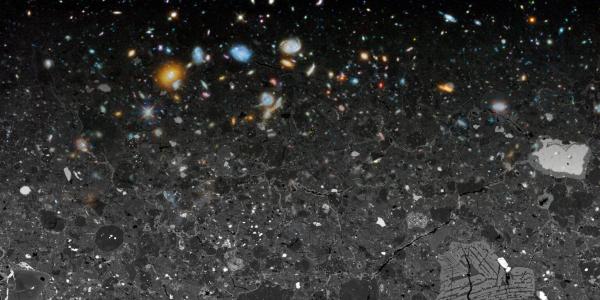Physicist Ryan Ogliore’s lab works to gain insight into something no longer observable: the formation and evolution of the early solar system.
More than 400 years ago, a Dutch eyeglass maker named Hans Lippershey invented the first telescope. Soon after, Galileo harnessed the equipment to glimpse the heavens, and ever since, scientists and backyard astronomers alike have been using these fundamental technologies to observe celestial bodies. Although telescopes provide valuable insights into the vastness of space and how matter is distributed, they primarily provide information about how things are – not necessarily how they came to be. To unravel the complex and prolonged history of the solar system, cosmochemist Ryan Ogliore, assistant professor of physics at WashU, uses microscopic analytical techniques to study grains formed during the solar system’s inception.

Ogliore’s research combines high-resolution imaging techniques and microscale chemical measurements to characterize extraterrestrial materials. These materials commonly take the form of meteorites and micrometeorites that fall to Earth, lunar rocks from Apollo missions, and, in some cases, exotic grains produced during supernovae explosions. By studying their physical characteristics and chemical compositions, Ogliore can infer how these materials formed and, more importantly, gain insight into early solar system conditions. Although Ogliore studies a wide variety of extraterrestrial materials, his research is unified in its aim to elucidate the formation and evolution of the solar system, beginning nearly 4.6 billion years ago.
“These grains are time capsules of the early solar system. Tiny grains from meteorites and cometary dust witnessed its formation,” said Ogliore. “With the analyses we do, we are trying to understand what they saw and develop a more complete timeline of the solar system’s evolution.”
To decipher the solar system’s cryptic history, Ogliore must first figure out which materials serve as good time capsules because they’ve retained their original chemical compositions. Most samples he studies are an amalgamation of minerals forged billions of years ago. As a whole, these meteorites have varied compositions, and many grains within them have been chemically altered. Much of this alteration can occur when entering Earth’s atmosphere at speeds greater than 11,000 meters per second, producing enough frictional heat to melt – or even evaporate – parts of the meteoroid. And once it reaches the Earth’s surface, minerals within can undergo rapid oxidation. Despite these challenges, some meteorites still contain pristine grains that formed billions of years ago as the solar system itself was forming.
Ogliore uses a scanning electron microscope (SEM) to locate grains of particular interest within a larger and potentially altered meteorite. In function, an SEM is similar to traditional light microscopy, but an SEM ‘illuminates’ samples using high-energy electrons, allowing features smaller than the wavelengths of visible light to be resolved. Ogliore typically captures thousands of electron images from each sample and uses custom software to stitch these images together, producing a single high-resolution mosaic image with roughly 10,000 times the resolution of smartphone photos. These high-resolution mosaics allow Ogliore to study samples virtually, mitigating risk to these precious samples, and share his findings with the public.
Yet locating these tiny time capsules is only the first step. Once found, Ogliore must measure the chemical composition of individual grains, a daunting task for such rare and physically small particles. To do this, he uses secondary ion mass spectrometry (SIMS) to measure the isotopic composition of individual grains, some of which have a diameter less than 1/70th of a human hair. These microscale isotope measurements are paramount to Ogliore’s research because they provide quantitative information that can be used to piece together a grain’s origin.
“A fundamental difference between astronomy and what we do is the fantastic precision we can achieve with our laboratory instruments,” Ogliore explained. “We can very precisely characterize a microscopic grain and pinpoint when and where it formed.”

The chemical elements inside a mineral – such as hydrogen, oxygen, aluminum, and silicon – only tell part of the story of how it formed. To investigate the processes that led to its formation, researchers turn their attention to isotopes, which are atoms of the same element with differing numbers of neutrons. An oxygen atom, for example, always has eight protons but can have either eight, nine, or ten neutrons. Throughout space and time, stellar processes have altered the isotopic composition of the universe’s building materials. And during mineral formation, various processes can lead to further changes in the isotopic ratios. By measuring the isotopic composition of primitive grains, Ogliore can infer when, where, and potentially how a mineral formed. By understanding how a mineral formed, Ogliore and colleagues can extrapolate what early solar system conditions were like and what cosmic events may have led to its formation.
In some cases, a sample may contain multiple crystals of the same mineral that are visually indistinguishable yet have radically different isotopic compositions. As an example, doctoral student Kainen Utt and Ogliore recently identified four crystals of a mineral called enstatite within a single cometary dust sample. These whisker-like crystals have similar physical characteristics and, based on their appearance alone, seemingly could have formed under similar conditions. But using SIMS, Utt and Ogliore measured oxygen isotopes from each enstatite crystal and found significant differences in isotope ratios, suggesting some of the crystals formed in vastly different regions of our solar system before they were incorporated into a single comet.
Together, findings like these provide valuable insight into something no longer observable: the formation and evolution of the early solar system. The work of Ogliore and his colleagues is helping unravel the complex and surprising history of our solar system, which may provide insights into how other planetary systems developed.
“I think this is cosmic chemistry's time to shine, and it's exciting,” said Ogliore. “It’s important to understand how planetary systems with habitable planets formed, and cosmochemistry can tell us very precisely how this happened in our solar system.”





